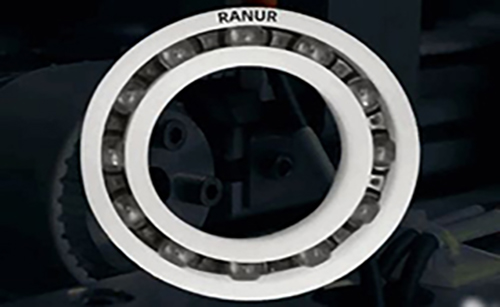Introduction to axial clearance and clearance grade of bearing:
Clearance: the clearance between the rolling element and the ferrule.
Precision: refers to the bearing size precision and rotation precision.
The accuracy of the bearing has a certain influence on the accuracy of the clearance, but has no influence on the size of the clearance. The clearance is set before delivery.

Radial internal clearance code:
Take NSK as an example
C2 < CN < C3 < C4 < C5 CN (some factories call it C0) is the standard clearance, larger than the standard clearance is called large clearance, smaller than the standard clearance is called small clearance.
CM clearance: special clearance for motor. The clearance value is between CN and C3, and the range is small.
MC1 < MC2 < MC3 < MC4 < MC5
Radial internal clearance of small diameter ball bearing (miniature bearing). MC3 is the standard clearance.
E and EN: radial internal clearance of magneto bearing.
Bearings with different accuracy can have different clearances.
For example, code P63 is a combination of precision code P6 and clearance code C3.
/C1 -- One group with clearance conforming to the standard, and the clearance is less than two groups.
/C2 -- 2 groups with clearance meeting the standard, and the clearance is less than 0 groups.
/C0 -- group 0 with clearance conforming to the standard, omitted in the code, not indicated.
/C3 -- 3 groups with clearance meeting the standard, and the clearance is greater than 0 groups.
/C4 -- 4 groups with clearance conforming to the standard, and the clearance is greater than 3 groups.
/C5 -- 5 groups with clearance meeting the standard, and the clearance is greater than 4 groups.
(Running Longteng, a world power, out of Dongfang Tengda, the world's high-end three types of self-aligning roller bearings, Longteng Liu Xingbang)
Is the smaller the radial clearance of the bearing the better?
Not all bearings require the minimum working clearance. You must select the appropriate clearance according to the conditions. In the national standard 4604-93, the radial clearance of rolling bearings is divided into five groups - 2 groups, 0 groups, 3 groups, 4 groups, and 5 groups. The clearance values are from small to large, and 0 group is the standard clearance. The basic radial clearance group is applicable to general operating conditions, conventional temperatures and commonly used interference fit; For bearings working under special conditions such as high temperature, high speed, low noise and low friction, large radial clearance should be selected; For precision spindles and bearings for machine tool spindles, smaller radial clearance should be selected; For roller bearings, a small amount of working clearance can be maintained. In addition, there is no clearance for separated bearings; Finally, the working clearance of the bearing after installation should be smaller than the original clearance before installation, because the bearing should bear a certain amount of load rotation, as well as the elastic deformation caused by bearing matching and load.
After the installation of the bearing, the operation inspection shall be carried out to check whether the installation is correct. Small machinery can be rotated by hand to confirm smooth rotation. The inspection items include poor operation caused by foreign matters, scars and indentations, unstable torque caused by poor installation, poor processing of the mounting base, and excessive torque caused by too small clearance, installation error and seal friction. If there is no abnormality, power operation can be started.
Power operation starts from no-load low speed and slowly increases to rated operation under specified conditions. During test run, check whether there is abnormal sound, temperature change of rolling bearing, lubricant leakage or discoloration, etc. If any abnormality is found, stop the operation immediately, check the machinery, and remove the bearing for inspection if necessary.
The bearing temperature can generally be inferred from the external temperature of the bearing pedestal. However, it is more accurate to directly measure the temperature of the bearing outer ring by using the oil hole. The temperature of rolling bearing rises gradually from the start of operation, and is generally stable after 1-2 hours. If the bearing is not installed properly, the temperature will rise sharply, resulting in abnormal high temperature. The causes include too much lubricant, too small clearance of rolling bearing, poor installation, excessive friction of sealing device, etc.
The rolling sound of the rolling bearing shall be checked with a stethoscope. If there is strong metal noise, abnormal sound, irregular sound, etc., it indicates that it is abnormal. The causes include poor lubrication, poor accuracy of shaft or bearing seat, bearing damage, foreign matter intrusion, etc.
